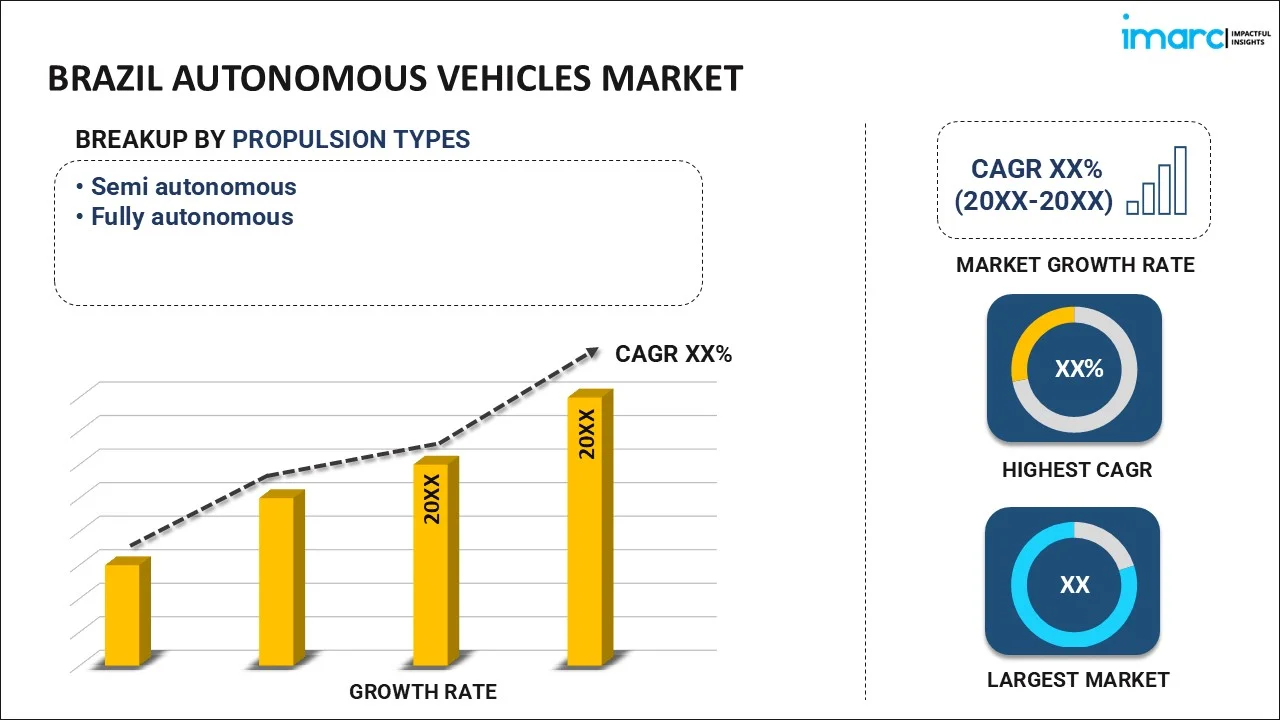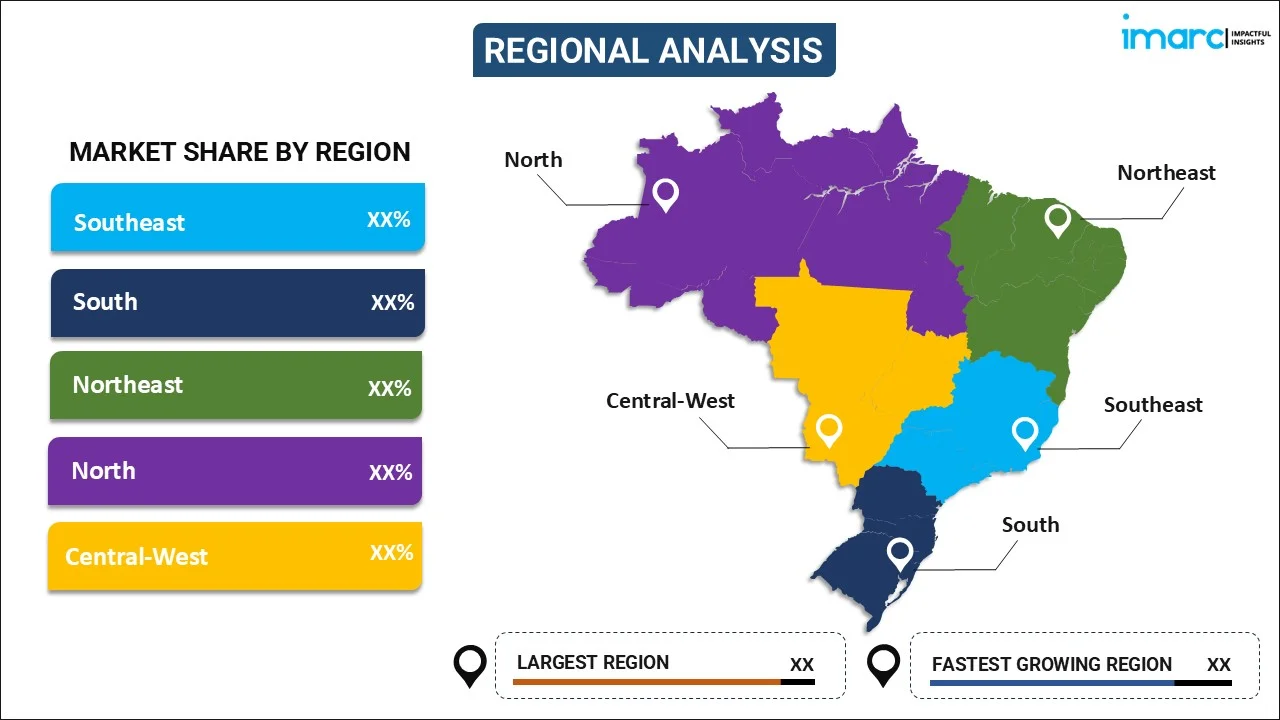
Brazil Autonomous Vehicles Market Size, Share, Trends and Forecast by Propulsion Type, Level, Vehicle Type, and Region, 2026-2034
Brazil Autonomous Vehicles Market Overview:
The Brazil autonomous vehicles market size reached USD 1.4 Billion in 2025. Looking forward, IMARC Group expects the market to reach USD 7.8 Billion by 2034, exhibiting a growth rate (CAGR) of 21.00% during 2026-2034. Significant advancements in artificial intelligence (AI) and machine learning (ML) technologies, rising demand for enhanced road safety, government support for smart mobility initiatives, technological innovations in sensors and connectivity, increasing investments in automotive research and development (R&D), and growing consumer interest in autonomous driving experiences are some of the key factors strengthening the Brazil autonomous vehicles market growth.
|
Report Attribute
|
Key Statistics
|
|---|---|
|
Base Year
|
2025 |
|
Forecast Years
|
2026-2034
|
|
Historical Years
|
2020-2025
|
| Market Size in 2025 | USD 1.4 Billion |
| Market Forecast in 2034 | USD 7.8 Billion |
| Market Growth Rate (2026-2034) | 21.00% |
Brazil Autonomous Vehicles Market Trends:
Advancements in AI and ML
The development of autonomous vehicles (AVs) depends on advancements in AI and ML. With these technologies, cars can analyze massive volumes of environmental data in real time, facilitating decision-making and complex road network navigation. AI-powered systems help vehicles interpret sensor data, such as inputs from cameras, radar, and LiDAR, to understand road conditions, detect obstacles, and anticipate potential risks, thereby expanding the Brazil autonomous vehicles market share. The continuous improvements in AI algorithms enhance the vehicles’ ability to learn from their surroundings and adapt to new driving scenarios. This trend is particularly important in Brazil, where the diverse terrain and unpredictable traffic patterns are boosting the demand for sophisticated autonomous driving capabilities.
The increasing focus on safety and government regulations
The country's high level of road accidents, with most instances blamed on human fault, is a major contributing factor to the rise in adoption of autonomous car technologies. The systems reduce risk by eliminating the impact of driver fatigue, distraction, and intoxication. This, in turn, is being complemented by the government and regulatory bodies in Brazil as they implement regulations that facilitate the construction and testing of autonomous vehicles at a gradual pace. For example, regulatory bodies like National Traffic Department (DENATRAN) and others are enacting frameworks ensuring the safe roll-out of the vehicles, ultimately having a beneficial effect on the Brazil autonomous vehicles market outlook. As a result, increased attention to safety is driving the growth of the market, with governments across the world setting up rules that make self-driving technologies ready for testing as well as commercialization.
The integration of smart city initiatives
Another key trend shaping the market is the integration of AVs within Brazil’s broader smart city initiatives. Major cities in Brazil, such as São Paulo and Rio de Janeiro, are exploring smart mobility solutions to address urban challenges like congestion, pollution, and inefficient public transportation. AVs are seen as integral to these smart city plans, offering solutions to improve traffic flow, reduce emissions, and enhance public transport efficiency. The incorporation of connected vehicle technologies with urban infrastructure, such as smart traffic signals and real-time data analytics is expected to boost the adoption of autonomous driving. Moreover, the rising investments in infrastructure development, including fifth-generation (5G) networks which are essential for enabling the communication between AVs and city systems, are aiding in market expansion.
Brazil Autonomous Vehicles Market Segmentation:
IMARC Group provides an analysis of the key trends in each segment of the market, along with forecasts at the country level for 2026-2034. Our report has categorized the market based on propulsion type, level and vehicle type.
Propulsion Type Insights:

- Semi Autonomous
- Fully Autonomous
The report has provided a detailed breakup and analysis of the market based on the propulsion type. This includes semi autonomous and fully autonomous.
Level Insights:
- Level1
- Level 2
- Level 3
- Level 4
- Level 5
A detailed breakup and analysis of the market based on the level have also been provided in the report. This includes level 1, level 2, level 3, level 4, and level 5.
Vehicle Type Insights:
- Passenger Type
- Commercial Type
A detailed breakup and analysis of the market based on the vehicle type have also been provided in the report. This includes passenger type and commercial type.
Regional Insights:

- Southeast
- South
- Northeast
- North
- Central West
The report has also provided a comprehensive analysis of all the major regional markets, which include Southeast, South, Northeast, North, and Central West.
Competitive Landscape:
The market research report has also provided a comprehensive analysis of the competitive landscape. Competitive analysis such as market structure, key player positioning, top winning strategies, competitive dashboard, and company evaluation quadrant has been covered in the report. Also, detailed profiles of all major companies have been provided.
Brazil Autonomous Vehicles Market News:
- In June 2023, Marcopolo, in collaboration with Brazilian startup Lume Robotics, introduced South America's first autonomous minibus prototype, developed over two years. The autonomous technology, integrated into the Volare Attack 8 model, operates fully without remote intervention. Marcopolo aims to extend this technology to all its buses with automatic transmissions.
Brazil Autonomous Vehicles Market Report Coverage:
| Report Features | Details |
|---|---|
| Base Year of the Analysis | 2025 |
| Historical Period | 2020-2025 |
| Forecast Period | 2026-2034 |
| Units | Billion USD |
| Scope of the Report |
Exploration of Historical Trends and Market Outlook, Industry Catalysts and Challenges, Segment-Wise Historical and Future Market Assessment:
|
| Propulsion Types Covered | Semi autonomous, Fully autonomous |
| Levels Covered | Level 1, Level 2, Level 3, Level 4, and Level 5 |
| Vehicle Types Covered | Passenger Type, Commercial Type |
| Regions Covered | Southeast, South, Northeast, North and Central West |
| Customization Scope | 10% Free Customization |
| Post-Sale Analyst Support | 10-12 Weeks |
| Delivery Format | PDF and Excel through Email (We can also provide the editable version of the report in PPT/Word format on special request) |
Key Questions Answered in This Report:
- How has the Brazil autonomous vehicles market performed so far and how will it perform in the coming years?
- What is the breakup of the Brazil autonomous vehicles market on the basis of propulsion type?
- What is the breakup of the Brazil autonomous vehicles market on the basis of level?
- What is the breakup of the Brazil autonomous vehicles market on the basis of vehicle type?
- What is the breakup of the Brazil autonomous vehicles market on the basis of region?
- What are the various stages in the value chain of the Brazil autonomous vehicles market?
- What are the key driving factors and challenges in the Brazil autonomous vehicles market?
- What is the structure of the Brazil autonomous vehicles market and who are the key players?
- What is the degree of competition in the Brazil autonomous vehicles market?
Key Benefits for Stakeholders:
- IMARC’s industry report offers a comprehensive quantitative analysis of various market segments, historical and current market trends, market forecasts, and dynamics of the Brazil autonomous vehicles market from 2020-2034.
- The research report provides the latest information on the market drivers, challenges, and opportunities in the Brazil autonomous vehicles market.
- Porter's five forces analysis assist stakeholders in assessing the impact of new entrants, competitive rivalry, supplier power, buyer power, and the threat of substitution. It helps stakeholders to analyze the level of competition within the Brazil autonomous vehicles industry and its attractiveness.
- Competitive landscape allows stakeholders to understand their competitive environment and provides an insight into the current positions of key players in the market.
Need more help?
- Speak to our experienced analysts for insights on the current market scenarios.
- Include additional segments and countries to customize the report as per your requirement.
- Gain an unparalleled competitive advantage in your domain by understanding how to utilize the report and positively impacting your operations and revenue.
- For further assistance, please connect with our analysts.
 Request Customization
Request Customization
 Speak to an Analyst
Speak to an Analyst
 Request Brochure
Request Brochure
 Inquire Before Buying
Inquire Before Buying




.webp)




.webp)












